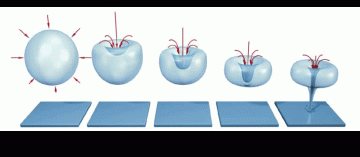High-temperature short time (HTST) pasteurization method has been widely used in dairy industry today; milk product is heated to 72 Celsius degrees for 15 seconds to kill most of the spoilage bacteria. However, thermal degradation of nutrients during the high-temperature treatment occurs (Lund, 1988). In order to reduce nutrient loss and maintain pasteurization efficiency, our team wanted to see if ultrasonication can be used along with heat treatment during pasteurization.

Ultrasound is an innovative technology that can be applied to a variety of areas including food processing, medical, and obstetric. The underlying mechanism is that an alternation between compression and rarefaction is induced by a mechanical wave. In the case of milk ultrasonication, as the ultrasonic wave travels through the aqueous phase of milk, a cavitation phenomenon can be resulted. With the accompany of acoustic effect and high pressure, the radicals resulted from the breakdown of water molecule are highly reactive with its surrounding and prompt the chemical reactions. By combining it with mild heat treatment, phosphatase enzymes and bacteria are eliminated without destructing nutrients (Wrigley and Llorca, 1992).
Also, the vigorous vibration of cavitation bubbles in liquid during ultrasonication produces strong eddies. Bubbles are attracted into ultrasonic field, and micro-streaming is created. The violent agitation generated by the micro-streaming facilitates homogenization, and promotes heat and mass transfer. The energy and high pressure created by the aforementioned process can effectively eliminate the survival of pathogen.
The primary purpose of our research is to test the synergistic effect of ultrasound and heat on the nutrient content of bovine milk. The hypothesis is that ultrasound plus heat will efficiently pasteurize milk product. Moreover, it will not adversely effect the nutrient content and physical characteristics of milk product. Using ultrasound along with heat to pasteurize milk product can provide the product with a higher quality than the traditional high-temperature short time (HTST) pasteurization method.
References:
Lund, D. (1988). Effects of Heat Processing on Nutrients. In E. Karmas & R. S. Harris (Eds.), Nutritional
Evaluation of Food Processing (pp. 319–354). Dordrecht: Springer Netherlands. doi:10.1007/978-94-011-7030-
7_12
WRIGLEY, D. M., & LLORCA, N. G. (1992). Decrease of Salmonella typhimurium in Skim Milk and Egg by Heat and
Ultrasonic Wave Treatment. Journal of Food Protection, 55(9), 678–680. doi:10.4315/0362-028X-55.9.678